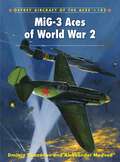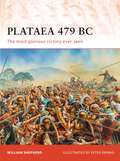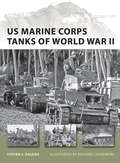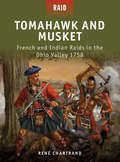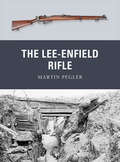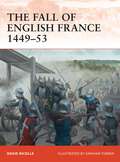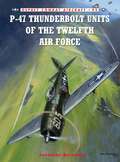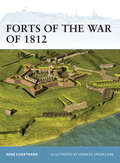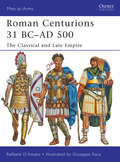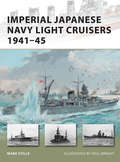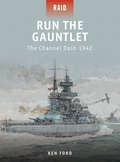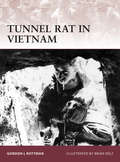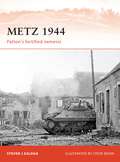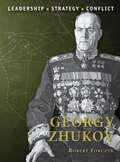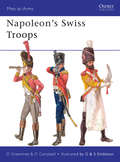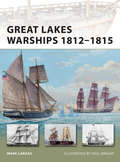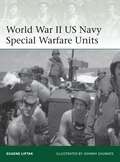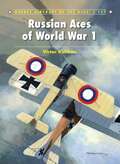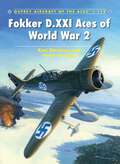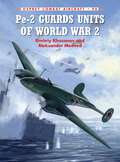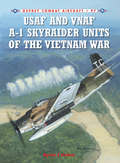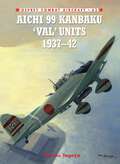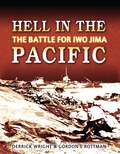- Table View
- List View
MiG-3 Aces of World War 2
by Dmitriy Khazanov Andrey YurgensonCreated by ex-Polikarpov designers Ivanovic Mikoyan and Mikhail Gurevich, the MiG-1/3 family of fighters was built to satisfy a Soviet Air Force requirement for an advanced, fast, high altitude fighter. Entering service in the spring of 1941, the problematic MiG-1 had its handling problems rectified with the hasty production of the MiG-3 - the latter had its Mikulin engine moved further forward, increased outer wing dihedral and a strengthened fuselage. As of 22 June 1941, Air Force manoeuvre units in the five borderline military districts could field 917 MiG-3s. Many of these were destroyed on the ground when the Germans launched Operation Barbarossa. Nevertheless, enough examples survived to allow pilots such as Stepan Suprun (Twice Hero of the Soviet Union), Aleksandr Pokryshkin (Thrice Hero of the Soviet Union) and Lev Shestakov (Hero of the Soviet Union) to claim a number of victories on the type. Early successes by units such as 23rd and 28th IAPs resulted in 35 aerial victories being claimed by MiG-3 pilots in the first eight days of the Great Patriotic War. Other units enjoyed similar levels of success, with MiG-3-equipped 15 and 31st IAP proving themselves to be the most combat-ready fighter units on the Northwestern Front. By the end of 1941, a handful of pilots had 'made ace' flying the MiG-3, despite the Soviet air forces having taken a fearful beating at the hands of the Luftwaffe. In 1942 MiG pilots actively participated in the defence of Leningrad, Moscow, Odessa, Kiev and Sevastopol, with still more aviators becoming aces as the year progressed. Amongst them was Aleksandr Pokryshkin, the second-highest scoring Russian ace with 59 victories to his name. He claimed his first five kills while flying a MiG-3 with 55th IAP. Stalin terminated MiG-3 production in October 1941, although the fighter remained in frontline service in large numbers until mid-1942. Surviving examples continued to serve with national air defence regiments until 1943.
Plataea 479 BC
by Peter Dennis William ShepherdPlataea was one of the biggest and most important land battles of pre-20th century history. Close to 100,000 hoplite and light-armed Greeks took on an even larger barbarian army that included elite Asian cavalry and infantry from as far away as India, with thousands of Greek hoplites and cavalry also fighting on the Persian side. At points in the several days of battle, the Persians with their more fluid, missile tactics came close to breaking the Greek defensive line and cutting off their supplies. But, in a fatal misjudgement when he nearly had the battle won, their general Mardonius committed the cream of his infantry to close-quarters combat with the Spartans and their Peloponnesian allies. He died and his men were finally crushed by heavier weaponry and superior discipline. Meanwhile, 250 miles to the east, the Greek navy inflicted an equally decisive defeat on the Persians, neutralising Xerxes' seapower in the Aegean. The tiny minority of Greek city states that actually took up arms against the invading forces of the mightiest empire yet seen in the ancient world had halted its western expansion and driven it back.The reconstruction of the battle of Plataea will draw on recent persuasive academic interpretations of the textual sources and visual evidence (mainly from near-contemporary vase paintings) for the early 5th-century method of hoplite fighting.From the Trade Paperback edition.
Apache Tactics 1830-86
by Adam Hook Robert WattThe Apache culture of the latter half of the 19th century blended together the lifestyles of the Great Plains, Great Basin and the South-West, but it was their warfare that captured the imagination. This book reveals the skillful tactics of the Apache people as they raided and eluded the much larger and better-equipped US government forces. Drawing on primary research conducted in the deserts of New Mexico and Arizona, this book reveals the small-unit warfare of the Apache tribes as they attempted to preserve their freedom, and in particular the actions of the most famous member of the Apache tribes - Geronimo.From the Trade Paperback edition.
US Marine Corps Tanks of World War II
by Steven Zaloga Richard ChasemoreThe US Marine Corps formed six tank battalions in World War II which saw combat in some of the most varied and extreme conditions of the Pacific theater. The Marine tank battalions fought on small coral atolls such as Tarawa, in the fetid jungles of the south west Pacific including Guadalcanal, in the lush central Pacific islands of the Marianas such as Saipan and Guam, and on the volcanic deserts of the Bonin islands such as Iwo Jima. The tank equipment of the Marine Corps was essentially the same as that used by the US Army: the M3 and M5A1 light tanks, and the M4 Sherman medium tanks. But the conditions and the opponent forced the Marine Corps to adapt both in terms of technical and tactical innovations. The numerous island landings forced the development of novel landing equipment, especially deep wading equipment to get the tanks safely ashore. Japanese defensive tactics in 1943-44 put a premium on American use of flamethrowers and the development of a variety of flamethrower tanks on the M3 light tank chassis. Deadly Japanese close-infantry tactics forced the development of novel methods of tank protection including the use of wooden armor to defeat the use of magnetic anti-tank devices. This book will examine the Marine use of tanks in World War II and the tactics and technology that made their experiences so unique in the annals of tank warfare.
Tomahawk and Musket - French and Indian Raids in the Ohio Valley 1758
by Peter Dennis Rene ChartrandIn 1758, at the height of the French and Indian War, British Brigadier General John Forbes led his army on a methodical advance against Fort Duquesene, French headquarters in the Ohio valley. As his army closed in upon the fort, he sent Major Grant of the 77th Highlanders and 850 men on a reconnaissance in force against the fort. The French, alerted to this move, launched their own counter-raid. 500 French and Canadians, backed by 500 Indian allies, ambushed the highlanders and sent them fleeing back to the main army. With the success of that operation, the French planned their own raid against the English encampment at Fort Ligonier less than fifty miles away. With only 600 men, against an enemy strength of 4,000, the French & Amerindians launched a daring night attack on the heart of the enemy encampment. This book tells the complete story of these ambitious raids and counter-raids, giving in-depth detail on the forces, terrain, and tactics.
The Lee-Enfield Rifle
by Peter Dennis Martin PeglerThe Lee-Enfield is one of the 20th century's most recognizable and longest-serving military rifles. It was adopted by the British Army in 1895 and only replaced by the L1A1 SLR in 1957; even then a sniper variant, the L42A1, was used until 1989, giving a service life of nearly a century. It saw combat from the Boer War onwards, and thousands are still in use today, notably by the Taliban in Afghanistan; it is estimated that 17 million have been produced. The Lee-Enfield featured an innovative detachable ten-round magazine; this large capacity, together with the weapon's revolutionary bolt-action operation, made it possible for well-drilled shooters to fire 20 to 30 rounds in 60 seconds (the 'mad minute'). This extraordinary speed gave rise to mistaken German reports of being opposed by massed machine guns in 1914. The Short Magazine Lee-Enfield (SMLE), introduced in 1903, set a new precedent in military rifles, being neither a carbine nor a full-length rifle but an ingenious compromise that was soon copied by other countries.The Lee-Enfield equipped British, Commonwealth and other forces throughout the world wars and well into the 1960s, giving excellent service in every kind of terrain and weather. Soldier's recollections of the rifle are overwhelmingly affectionate (it was known as the Smellie); today it remains a very popular target rifle for competitive shooting, and modern copies are being manufactured to meet demand.Featuring first-hand accounts, brand-new full-colour artwork and close-up photographs, many in colour, this is the story of the Lee-Enfield, the innovative, reliable and long-lived rifle that equipped British and other forces through the world wars and beyond.
The Fall of English France 1449-53
by David Nicolle Graham TurnerFor the overwhelming majority of people outside the French-speaking world the Hundred Years War consisted of a sequence of major English victories, above all Crécy, Poitiers and Agincourt. The only significant victor or 'hero' on the French side was Joan of Arc, and she ended up being burned at the stake. Yet somehow the war ended in a French victory and with England's martial energies being turned against itself in the Wars of the Roses. This book is intended to provide some balance. It will describe the campaign that brought the Hundred Years War to a close, with English possessions being confined to Calais and the Channel Islands. It will also explain how the somewhat unprepossessing and unmartial King Charles VII of France succeeded where his predecessors had failed. The campaign consisted of more than battles, of course, but it was marked by two major victories - at Formigny in 1450 and at Castillon in 1453. Formigny is of special interest because it saw French cavalry defeat English archers, in effect a reversal of Crécy, Poitiers and Agincourt, and could be interpreted as one of the last 'medieval' battles. Castillon is of interest because it was a victory of gunpowder artillery in fixed positions over a traditional medieval assault by mixed infantry and cavalry, and thus could be interpreted as one of the first 'modern' battles.
P-47 Thunderbolt Units of the Twelfth Air Force
by Chris Davey Jonathan BernsteinThe P-47 Thunderbolt, originally designed as a high-altitude interceptor, became the principle US fighter-bomber of World War 2. First adapted to the ground attack role by units of the Twelfth Air Force in early 1944, the strength and durability of the P-47 airframe, along with its massive size, earned it the nickname 'Juggernaut', which was quickly shortened to 'Jug' throughout the MTO and ETO. Twelfth Air Force fighter groups had done a superb job flying both tactical strike missions and bomber escort in the P-40F since late 1942. The sturdy and capable Curtiss fighter served well as a fighter-bomber, but still remained susceptible to ground fire due to its liquid-cooled inline engine. Alongside the Twelfth's P-40 units, an additional two fighter groups flew the A-36 dive-bomber version of the P-51 Mustang and several others employed the twin-engined P-38 and mid-engined P-39. By October 1943, with the creation of the Fifteenth Air Force, nearly half of the Twelfth's fighter groups would be re-tasked with strategic escort missions, leaving six groups to perform close air support and interdiction missions throughout the entire Mediterranean theatre. The remaining P-40 and A-36 groups began refitting with the P-47 in the early spring of 1944 and were the first to use the 'Jug' in the ground support role, creating many of the tactics, techniques and procedures that would become standardised throughout the USAAF's tactical air forces. The group's inflicted incredible damage on the enemy's transport routes in particular, using rockets, bombs, napalm and machine gun rounds to down bridges, blow up tunnels and strafe trains. Myriad firsthand accounts and period photography reveal the spectacular success enjoyed by the Thunderbolt in the MTO in the final year of the war.
Forts of the War of 1812
by René Chartrand Donato SpedaliereWhen war broke out between the United States and Great Britain in 1812, neither side was prepared for the conflict, as evidenced by their respective fortifications. The most sophisticated and modern fortifications were those built by the US Corps of Engineers to protect some of the main port cities. These included Fort Mifflin in Philadelphia, Fort McHenry in Baltimore and Castle William in New York. The British also heavily fortified their main harbor at Halifax and their main center of power at Quebec. However, elsewhere, especially in the interior, fortifications were old, neglected or only hastily erected. The forts at Detroit and Mackinac were much as the British had left them in 1796. This book covers all of the main fortifications of the conflict, those that faced the crashing of guns and those whose intimidation played a part in the grand strategy of the war.
Roman Centurions 31 BC-AD 500
by Giuseppe Rava Raffaele D'AmatoIn the years between 31 BC and AD 500 the Romans carved out a mighty empire stretching from Britain to the deserts of North Africa. The men who spearheaded this expansion were the centurions, the tough, professional warriors who led from the front, exerted savage discipline and provided a role model for the legionaries under their command.This book, the second volume of a two-part study, reveals the appearance, weaponry, role and impact of these legendary soldiers during the five centuries that saw the Roman Empire reach its greatest geographical extent under Trajan and Hadrian, only to experience a long decline in the West in the face of sustained pressure from its 'barbarian' neighbours. Featuring spectacular full-colour artwork, written by an authority on the army of the Caesars and informed by a wide range of sculptural, written and pictorial evidence from right across the Roman world, this book overturns established wisdom and sheds new light on Rome's most famous soldiers during the best-known era in its history.
Imperial Japanese Navy Light Cruisers 1941-45
by Paul Wright Mark StilleLike their heavy cruiser brethren, the light cruisers built by the Imperial Japanese Navy in the build-up to WWII paid little more than lip service to the international naval treaties that were intended to keep the naval powers on a level playing field. The eight classes of light cruiser developed by the IJN were fast, well-armed, and technologically superior to the fleets the Allied powers could bring to bear. Serving with distinction across the Pacific Theatre, the IJN's light cruisers were committed to such actions as Midway and Leyte Gulf. Mark Stille continues Osprey's coverage of the IJN of WWII, with this concise and complete study of all 25 ships of the 8 light cruisers classes, from their design and development through to their ultimate fates. Detailed Osprey artwork and rare period photographs from the Fukui collection held in Kure, Japan, illustrate this discussion and provide great visual references for some of the most advanced naval vessels of WWII.
Run The Gauntlet - The Channel Dash 1942
by Howard Gerrard Ken FordIn February 1942, three of the major ships of the German surface fleet - the battle-cruisers Scharnhorst and Gneisenau, and the heavy cruiser Prinz Eugen - stormed out of the harbour at Brest on a dramatic voyage back to Germany. Passing through the straights of Dover, the ships faced everything the Royal Air Force and the Royal Navy could throw at them. In a dramatic running fight, the ships managed to sail right under the nose of history's greatest maritime nation to reach the safety of Germany. The brilliantly executed operation brought great humiliation to the British - Hitler, who had developed the plan, had judged perfectly the reaction of the British command to the Channel Dash. Repositioned, these fast, heavily armed ships went on to threaten the Allied Arctic convoys that kept Russia in the war at Stalingrad. This book tells the complete story of this great race, from the planning through to the repercussions of this unique Germany victory.
Tunnel Rat in Vietnam
by Gordon Rottman Brian DelfIn 1965, soon after the first US combat troops had arrived in Vietnam, it was realized that in some areas the Viet Cong had developed vast tunnel complexes in which to hide from the enemy. It was long known that such complexes existed, but it was not realized just how extensive they were in some areas, how important they were to the Viet Cong, and how difficult it was to detect and neutralize them.Most complexes were not nearly as developed and extensive as the famous tunnels of Cu Chi, but nonetheless they caused difficulties for Free World Forces. Tunnels served as hiding places for soldiers, weapons, ammunition, food, and supplies and negated the purpose of search and destroy missions intended to root out the Viet Cong. Once the Free World Forces had "cleared" the area the Viet Cong emerged from their tunnels and continued their activities.It did little good to learn how to detect tunnel entrances and air holes and not ferret out the enemy. Someone had to go in and get them. Not only that but the extent of the tunnel complexes needed to be discovered, weapons, munitions, supplies, and documents had to be recovered or destroyed, and the tunnels themselves had to be destroyed or neutralized to prevent their continued use.At first infantrymen volunteered to enter the tunnels armed with only pistols and flashlights - the "tunnel runners" were born, known to the Australians as "tunnel ferrets."Starting as an ad hoc force of infantrymen, combat engineers and chemical troops, it was not long before units were "formalized" as "tunnel exploration personnel" and 4-6-man"tunnel exploitation and denial teams" were created. They came to be known simply as "tunnel rats" with the unofficial motto, Non Gratum Anus Rodentum--"Not Worth a Rat's Ass."This title will be based on the personal accounts of those who served in this unique role, and will describe the specialist training and equipment, not to mention the tactics and combat experiences, of those who fought an underground war against the Viet Cong in Vietnam.
Metz 1944
by Steven Zaloga Steve NoonGeneral George Patton's most controversial campaign was the series of battles in autumn 1944 along the German frontier which centered on the fortified city of Metz. It took nearly four months, from September to December 1944, for Patton's Third Army to capture the Metz-Thionville fortified zone. In part, the problem was logistics. As was the case with the rest of the Allied forces in the European Theatre, supplies were limited until the port of Antwerp could finally be cleared. Also problematic was the weather. The autumn of 1944 was one of the wettest on record, and hardly conducive to the type of mechanized warfare for which Patton was so famous. However at the heart of the problem was the accretion of sophisticated fortifications. Metz had been fortified since ancient times, heavily rebuilt by France in the post-Napoleonic period, modernized by Germany in 1870-1914, and modernized by France during the Maginot effort in 1935-40. The Germans hoped to hold Metz with a thin screen of second-rate troops, counting on the impregnable fortifications. This book covers the entire campaign from beginning to end, offering an unbiased assessment of the success and failures of both the Allied and Axis efforts.
Georgy Zhukov
by Robert Forczyk Adam HookZhukov was the dominant figure in the Red Army during World War II even though his actual job title varied from day to day. Serving as a senior General Staff representative from the Stavka, Zhukov moved from one critical sector to the next, serving as advisor, coordinator and de facto front commander as required. There is no doubt that Zhukov played a critical role in salvaging the critical situation in the fall of 1941 and leading the Red Army to an amazing reversal of fortunes in 1942-43 and eventual victory in 1944-45. He was instrumental in the initial defence of Leningrad, before moving to Moscow to stem the German advance and lead the counterattack in the winter of 1941. In 1942-43 he was responsible for Operation Uranus that cut off the German 6. Armee in Stalingrad, and led the defence of the Kursk Pocket against Manstein's attacks. His was the voice of reason and patience that convinced Stalin to let the Germans expend themselves at Kursk before launching the Soviet offensive that drove the Germans back hundreds of miles and almost broke the German Army inthe Ukraine. Without him Kursk would never have been fought as a defensive battle by the Russians. In 1944 he led the massive Soviet Operation Bagration that destroyed the German Heeresgruppe Mitte and continued on in command of front through to the end of the war, which saw him become the first post-war Soviet commander in East Germany.However, Zhukov's methods were brutal and contributed to massive Soviet casualties, while he continued to keep his hand in political affairs as well. As the most recognized Soviet soldier of World War II, Zhukov's post-war fall from grace was equally precipitous and it was not until the fall of the Soviet Union that he was awarded his reputation was restored.
Napoleon's Swiss Troops
by Gerry Embleton David GreentreeEver since the 15th century Switzerland had been exporting professional soldiers to serve as mercenaries for foreign monarchies. Napoleon, therefore, was not the first to make full use of the martial qualities of the Swiss and obtained Swiss agreement to expand the recruitment of regiments for service in the French Army. Napoleon would use Swiss troops on the battlefields of Italy and Spain, and in 1812 re-organize the four original regiments into a single division for the invasion of Russia, with each regiment having three full-strength battalions. In all theatres where they were engaged, Swiss contingents would often be relied upon to act as rearguards so other forces caught in a tight situation could escape. Time and again they would be asked to save the day for the French soldiers with whom they fought, in Italy and Spain and most famously for Napoleon himself, in Russia. In November of 1812, meeting up with Napoleon's main force retreating from Moscow at the Berezina River, the Swiss on the west bank guarded the approaches to the pontoon bridges from the Russian attack to the south. 1,200 Swiss, out of approximately 8,000 that entered Russia, were left to face, along with 8,000 men from other units, the 30,000-strong Russian army. The Swiss held their ground and when their ammunition ran out they charged the Russians with bayonets. This book reveals the proud combat history of the Swiss troops of Napoleon's army as well as the colourful uniforms they wore.
Great Lakes Warships 1812-1815
by Paul Wright Mark LardasWhen war broke out in 1812, neither the United States Navy nor the Royal Navy had more than a token force on the Great Lakes. However, once the shooting started, it sparked a ship-building arms race that continued throughout the war. This book examines the design and development of the warships built upon the lakes during the war, emphasizing their differences from their salt-water contemporaries. It then goes onto cover their operational use as they were pitted against each other in a number of clashes on the lakes that often saws ships captured, re-crewed, and thrown back against their pervious owners. Released in 2012 to coincide with the 200th anniversary of the outbreak of the war, this is a timely look at a small, freshwater naval war.
The Hunt for Pancho Villa - The Columbus Raid and Pershing#s Punitive Expedition 1916-17
by Peter Dennis Alejandro QuesadaOn March 9, 1916, troops under the command of Pancho Villa attacked Columbus, New Mexico and its local detachment of the US 13th Cavalry Regiment, killing 18 people and burning the town. Six days later, on orders from President Woodrow Wilson, General John J. "Black Jack" Pershing led an expeditionary force of 4,800 men into Mexico to capture Villa. What followed was a series of skirmishes, battles, and chases through the wild and uncharted Mexican countryside. While the Americans failed in their ultimate purpose of catching Villa, they did kill two of his top lieutenants. This book charts the progress of the entire enterprise, covering the dusty marches and the bitter gunfights in the streets of small border towns, analyzing the successes and failures of this unique military expedition.
World War II US Navy Special Warfare Units
by Johnny Shumate Eugene LiptakWhen the United States entered World War II, it was apparent that the war would only be won by taking the fight to the Axis, in the shape of large-scale amphibious landings. Accordingly, the US Navy developed several types of specialized unit to reconnoiter potential landing areas, degrade the enemy's ability to resist, and assist the landing forces on to the beaches. These operatives had to get there first, alone, and carry out their missions before the GIs and Marines could land with any chance of success.Formed in September 1942 and active in the Mediterranean, European, and Pacific theaters, the Scouts and Raiders were forerunners of the SEALs; they used canoes to secretly reconnoiter beaches before combat landings, and placed marker beacons. In the Mediterranean and the Philippines, the Beach Jumpers made elaborate simulated landings to fool the enemy as to real locations, including radar and sound deception.Active in the Mediterranean, Normandy, and the South West Pacific, the Naval Combat Demolition Units cleared beach obstacles in advance of combat landings, and guided landing craft to their destination, while the Underwater Demolition Teams carried out similar tasks in the Pacific theater only. In co-operation (and sometimes competition) with the Office of Strategic Services, Naval Group China gathered intelligence in that theater, and trained and fought with Chinese guerrillas behind Japanese lines.All these special warfare units played vital roles in the prosecution of the Allied war effort across the globe. Their distinctive uniforms, insignia, special clothing, equipment, and weaponry are illustrated and described in this engaging study.
Russian Aces of World War 1
by Harry Dempsey Victor KulikovAlthough the Russian Imperial Army Air Service consisted of no more than four BAGs (Boevaya Aviatsionniy Gruppa - battle aviation groups), each controlling three or four smaller AOIs (Aviatsionniy Otryad Istrebitelei - fighter aviation detachments) equipped with a variety of aircraft types, its fighter pilots nevertheless gave a good account of themselves. Indeed, during three years of war they claimed more than 200 Austro-Hungarian and German aircraft shot down, creating 13 aces - these elite aviators accounted for around half of the victories claimed on the Eastern Front. Pilots flew a variety of fighter types, with French Nieuport scouts and SPAD VIIs proving to be the most popular, and effective, aeroplanes to see service on this front. The exploits of these aces are detailed here, with information based on material newly sourced by the author from Russian military and private archives. Many previously unpublished photographs are used to illustrate this book, supported by full-colour profiles that reveal how striking some of the aces' fighters were in this often-forgotten theatre of World War I.
Fokker D.XXI Aces of World War 2
by Chris Davey Kari StenmanEntering service with the Dutch air force from early 1938, the aircraft was also built under license in Denmark and Finland. Production was also scheduled to commence in Spain too but Nationalist forces overran the factory before this commenced. The Dutch D.XXIs saw less than a week of action following the German invasion of the west on 10 May 1940, with many of the country's 28 fighters being destroyed on the ground. However, those that survived the initial onslaught inflicted losses on the Luftwaffe, 15 pilots sharing in the destruction of 14 German aircraft (fighters, bombers and transports). By then, however, the D.XXI had found everlasting fame in Finland during the Winter War of 1939-40. Proving itself a real thorn in the side of the Soviets, the fighter, operating in primitive conditions and against vastly superior numbers, Finnish D.XXIs racked up an incredible score against the Red Air Force, and in particular its bomber units. No fewer than ten pilots became aces during this brief, but bloody, campaign, with a similar number claiming four victories and subsequently 'making ace' in later types. The sturdy D.XXI was highly rated by the leading Finnish pilots of the time, boasting a good rate of climb and the ability to break off combat when required thanks to its high speed in a dive. The D.XXI also has the distinction of producing the first 'ace in a single mission' in World War 2, when then 1Lt Jorma Sarvanto shot down six Ilyushin DB-3 bombers on 6 January 1940. After spending a year providing home defence and flying coastal patrols during the early stages of the Continuation War in 1941, all surviving Finnish Fokker D.XXIs were relegated to the reconnaissance role, which they performed through to the end of hostilities in September 1944.
Pe-2 Guards Units of World War 2
by Dmitriy Khazanov Andrey YurgensonPetlyakov's Pe-2 was the most numerous Soviet twin-engined bomber of World War 2, the aircraft being used as a dive-bomber, ground attack platform and dedicated reconnaissance type. The first examples entered service in August 1940, and by the time production came to end in late 1945, no fewer than 10,547 examples had been built. These equipped more than 80 bomber air regiments, and of the latter, two were accorded Guards Air Corps status, as were six air regiments. Amongst the former was the 2nd Guards Bomber Air Corps, which was commanded by the legendary General Polbin, who was twice made a Hero of the Soviet Union. Pe-2 bomber and reconnaissance versions (the latter in service with four Guards reconnaissance air regiments of the Air Force and one regiment of Naval Aviation) were extensively used from the frozen Arctic north to the balmy Crimea front. A number of Pe-2 also saw brief combat against Japan in the final weeks of World War 2.
USAF and VNAF A-1 Skyraider Units of the Vietnam War
by Jim Laurier Byron HukeeUSAF Skyraider units were originally tasked to serve as quasi-training units for the fledgling VNAF. Equipped only with the two-seat models of the Skyraider, American pilots were required to have VNAF 'observers' in the aircraft for every mission. Eventually, this arrangement was changed as enough Vietnamese pilots were trained to man their own squadrons, while USAF squadrons were tasked with close support for US ground forces. Eventually, no fewer than four USAF and seven VNAF Skyraider units saw service in Vietnam. Additionally, one A-1 training squadron flew from Hurlburt Field, Florida, throughout the Vietnam War era. In the ten years that this squadron was active, nearly 1000 USAF and 300 VNAF pilots were trained in the Skyraider. While the core mission of all Skyraider squadrons was Close Air Support (CAS), other missions were accomplished at various times. Among these were Search and Rescue (SAR), night interdiction on the Ho Chi Minh trail, helicopter escort and special forces support to name but a few. Each of these missions took full advantage of the Skyraider's ability to deliver a variety of munitions in close proximity to friendly forces while inflicting heavy casualties on enemy forces
Aichi 99 Kanbaku 'Val' Units
by Jim Laurier Osamu TagayaThe Aichi Type 99 Carrier Bomber (D3A) - code named 'Val' by Allied intelligence - was the mainstay of the Imperial Japanese Navy's carrier dive-bomber force from 1941 to 1943. It sank more Allied warship tonnage than any other Axis aircraft during World War II (1939-1945). While the Val's participation in the major carrier battles has been widely covered in other English language sources, details of its operations have received scant attention in English. This book explores the Val's combat operations. Colour illustrations and photographs complement the development of dive-bombing methods in the IJN.
Hell in the Pacific
by Derrick WrightThe battle of Iwo Jima was extraordinary for its ferocity. US Marine Corps casualties exceeded by thousands the number of Japanese defenders, who fought almost to the last man over those five desperate weeks. The strategic justification for the mission has been challenged and the iconic photograph of the flag-raising was staged, but there is no questioning the courage displayed (winning the USMC 24 Medals of Honor) and the horrors endured by both sides. The Japanese were dug into a vast and complex defensive network of trenches, bunkers, caves and tunnels commanding every square foot of the island's volcanic rock and black sand. The Marines' task was to fight almost every step of the way from their landing beaches to the northern tip where victory was finally secured, developing new tactics to deal with this well-entrenched, determined and heavily-armed resistance as they progressed from objective to objective. This book details the composition, weaponry and leadership of the opposing forces and reviews their plans. It also closely examines the individual fighting men on each side, the USMC infantryman and the Imperial Japanese soldier, contrasting their training, equipment, culture and battlefield experiences. Having laid out the background, the authors then follow the battle through its several phases from the landings to General Kuribayashi's last banzai. Their clear narrative, supported by numerous maps, tactical diagrams and photographs, answers in detail the question which other accounts of this great battle only address at a more general level: how did the Marines do it?From the Hardcover edition.
